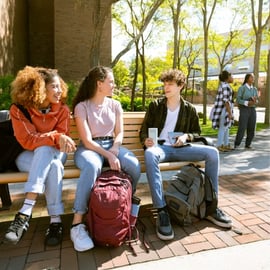Creating Connection Points & Strengthening Community

 It’s probably not ground-breaking news that today’s college and university students are facing many challenges as they come of age in this rapidly changing world. With technological advancements and economic shifts converging, they are facing a lot of uncertainties as they prepare to enter the workforce. And I’m sure it seems daunting.
It’s probably not ground-breaking news that today’s college and university students are facing many challenges as they come of age in this rapidly changing world. With technological advancements and economic shifts converging, they are facing a lot of uncertainties as they prepare to enter the workforce. And I’m sure it seems daunting.
Which is why it’s more critical than ever to lighten the mood and create a sense of community on campus. It’s important that we not only listen to students but communicate in ways that recognize the complexities they face, embrace them as members of a larger community, and help them navigate the stresses of modern-day life with confidence. After all, it’s only by setting up today’s students for success that college and university communities thrive and are ultimately successful.
Making Time for Fun
With their future feeling so tenuous, it’s no wonder that this generation prioritizes fun and small indulgences. According to a 2024 YPulse Kidulting Trend Report1 surveying 18- to 24-year-olds, 76% need regular “escapes” from being an adult. Additionally, 62% are willing to splurge on things that help them cope with the world. These shifts are directly a reflection of Gen Z’s penchant for “treat culture,” or the notion that coping with life’s daily trials and tribulations deserves sweet treats, decadent snacks, or other regular rewards to soothe away the day’s worries.
Creating Meaningful Connection Points
But it's not only treats. They also enjoy storytelling and characterization of brands to help them escape. And we’ve seen how powerful it can be to employ visual symbols that are centered around the campus experience by watching the success stories play out on our partner campuses.
When brands successfully personify their identity — like Duolingo with its incredibly popular owl on TikTok or the timeless appeal of Hello Kitty — they create a relatable, emotional connection point that goes far beyond a simple transaction.
Another example of this is brilliantly highlighted in the fourth chapter of the President to President thought leadership series, “Building Campus Belonging at Moravian University,” where Moravian University President Bryon L. Grigsby, Ph.D., describes the coordinated initiatives he used to strengthen campus belonging, inspire school pride, and elevate community spirit. President Grigsby explains how one particular initiative really took on a life of its own when his adopted rescued greyhound Mo quickly became a fixture on campus, inspiring new merchandise, a recognition program, and many fun “university battle cries” that served to strengthen the university’s brand identity and connect students with Moravian’s campus culture. While greyhounds have served as longtime Moravian mascots, Mo became the beloved embodiment of campus community and pride, mobilizing the campus and helping students connect with Grigsby, and one another, in a way he’s never seen before.
We’ve seen how powerful it can be to employ visual symbols that are centered around the campus experience by watching the success stories play out on our partner campuses.
From Mascots to Meaningful Campus Culture
As the owner of two rescue cats — nicknamed for Sodexo’s Experiences Matter program brand mascots Ned and Sparky — the message in President Grigsby’s approach immediately struck a chord with me. It’s easy to see how Mo and my own adorable mascots inspire feelings of devotion and joy.
My cat Ned creates a spark when he meets someone for the first time. He wakes up every day looking for his next adventure and is eager to turn each encounter into a special experience. Then there’s his cat Sparky, who is happy to play a supporting role. Ned and Sparky differ in that Ned is the thinker, while Sparky is the doer. And you know what? Their two personalities complement one another! They cooperate, communicate, and thrive knowing that everyone in the house has a role to play.
 Although my cats don’t accompany me to campuses, thinking about their dynamic serves as a constant reminder about how essential it is to ensure that every student has an opportunity to have fun and contribute to campus life in ways that inspire a sense of belonging. In my role as a major champion of Sodexo’s resident dining programs, I realize how critical it is to develop connection points on campus that today’s students can relate to — whether it’s with an endearing mascot or other rallying points that engage students and make them proud to be a part of their campus community in whatever way they feel most comfortable.
Although my cats don’t accompany me to campuses, thinking about their dynamic serves as a constant reminder about how essential it is to ensure that every student has an opportunity to have fun and contribute to campus life in ways that inspire a sense of belonging. In my role as a major champion of Sodexo’s resident dining programs, I realize how critical it is to develop connection points on campus that today’s students can relate to — whether it’s with an endearing mascot or other rallying points that engage students and make them proud to be a part of their campus community in whatever way they feel most comfortable.
When a Brand Becomes a Lifestyle
What Sodexo and Moravian clearly understand is that introducing a visual representation of a brand is about more than just putting an adorable face on a t-shirt. It’s about bringing an idea to life that is clearly aligned with the “brand vibe” and is meaningful in the cultural context of its audience. Failure to do this with Gen Z and Gen Alpha can be disastrous because while these students have an affinity for brand mascots and personification, they are also incredibly literate in subtext and tone. They recognize and disregard “fluff” immediately.
Knowing that today’s students respond positively to brand mascots — but are also acutely aware of inauthenticity — we worked hard to ensure that our resident dining brand, One & All, felt natural and reflected today’s culture. Our own brand hosts, “One” and “All,” personify the Sodexo brand by representing a central gathering space where everyone can be themselves and belong. Presented together, they communicate an uplifting, playful message where accommodating different needs, styles, and preferences is celebrated.
 For example, some students may feel like “One,” the introvert who needs quiet time to recharge, refuel, and reflect. Those same students may have days where they feel like “All,” the breezy extrovert who thrives in an energetic atmosphere with opportunities to socialize. Sodexo’s brand mascots communicate the feeling that there is something for everyone in the dining hall, whether that means sharing meals with friends at a table for six or finding a quiet, comfortable spot to gather thoughts ahead of a big exam.
For example, some students may feel like “One,” the introvert who needs quiet time to recharge, refuel, and reflect. Those same students may have days where they feel like “All,” the breezy extrovert who thrives in an energetic atmosphere with opportunities to socialize. Sodexo’s brand mascots communicate the feeling that there is something for everyone in the dining hall, whether that means sharing meals with friends at a table for six or finding a quiet, comfortable spot to gather thoughts ahead of a big exam.
Half of 13- to 24-year-olds surveyed won’t buy from a brand they feel has cringey marketing, and 59% of 18- to 24-year-olds and 68% of 13- to 17-year-olds won’t buy from a brand that feels inauthentic.
2024 YPulse Cringe Report2
Bringing the Campus Together While Celebrating the Individual Experience
Like everything we do, Sodexo is using our dining concepts to drive authentic experiences that resonate with the diverse needs of today’s sophisticated, brand-savvy students. By working closely with our campus partners — and coordinating with our highly trained staff as we develop initiatives — Sodexo strives to create a dining experience where students feel connected, prepared to navigate life’s challenges, and can truly thrive in the days, semesters, and years to come.
1 Kidulting Trend Report – YPulse. (2024, February). YPulse. https://www.ypulse.com/report/2024/02/01/kidulting-trend-report/
2 The Cringe Trend Report – YPulse. (2025, August 7). YPulse. https://www.ypulse.com/report/2025/08/07/the-cringe-trend-report/